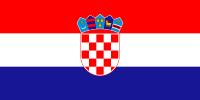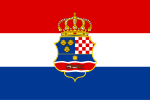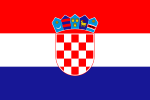Flag of Croatia
| Flag of Croatia | |
|---|---|
 |
|
| Vexillological symbol : |
|
| Aspect ratio: | 1: 2 |
| Officially accepted: | December 22, 1990 |
The flag of Croatia is a horizontal tricolor in the colors red , white and blue , with the coat of arms of Croatia placed in the middle . It was declared the national flag on December 22, 1990 .
The red-white-blue tricolor has since the 19th century, a symbol of Croatian law and was in the 20th century, a symbol of the Croats . From 1848 the Croatians adopted the red-white-blue flag colors, which are supposed to show the colors of the coats of arms of Croatia , Dalmatia and Slavonia . At the same time the Pan-Slavic colors are used.
National flag
description
The national flag consists of three horizontal stripes of the same size, red, white and blue, in front of which is the coat of arms of Croatia . The checkerboard pattern of the coat of arms begins with a red field in the top left. The aspect ratio of the flag is 1: 2.
Colours
| system | red | White | blue | Light blue in the coat of arms | Gold in the coat of arms | Black in the coat of arms |
|---|---|---|---|---|---|---|
| RGB | 222-24-24 | 255-255-255 | 0-41-140 | 8-123-165 | 255-250-0 | 0-0-0 |
| Hexadecimal format | # DE1818 | #FFFFFF | # 00298C | # 087BA5 | # FFFA00 | # 000000 |
history


The tricolor was first used in 1848, partly with the coat of arms of the Triune Kingdom of Croatia, Dalmatia and Slavonia . It didn't matter that the Netherlands already used the same color arrangement, as the country is only part of the k. u. k. -Reichs Austria-Hungary was. Since then, the tricolor has been the symbol of the Croats, even if various regimes banned it: as early as 1852 due to the revolutionary movements of 1848/49. Only the national colors were permitted , flags with two horizontal stripes, the colors of which were derived from the respective coat of arms. For Croatia red and white, for Slavonia blue and white and for Dalmatia blue and yellow.
From 1867 the sovereign used the tricolor with the coat of arms of the Triune Kingdom (in the coat of arms the partial coats of arms of Croatia and Dalmatia had swapped positions) and officially introduced them in 1868. On June 19, 1876, the appearance of the flag was specified more precisely. The Croatian- Hungarian Agreement of 1869 and the Edict of September 16, 1876 had already added the Hungarian St. Stephen's Crown . On December 20, 1899, the symbols of Croatia and Dalmatia exchanged their positions in the coat of arms. In 1894 the flag was produced in large quantities in Zagreb as a textile print.
After the First World War , Slovenes, Croats and Serbs declared their independence from Austria-Hungary and the red-white-blue tricolor became the flag of the only briefly existing state on October 29, 1918, which soon after, on December 1, 1918, became part of the Kingdom of the Serbs, Croats and Slovenes rose and abolished the old tricolor. From 1922, a blue-white-red tricolor was used as the flag of the new kingdom , as none of the individual states had previously used this color sequence as a flag. The red-white-blue flag remained as the regional flag of the Croatians, albeit illegal since 1918, because the government in Belgrade sought to merge the various nations.
 ? Flag of the Croatian Kingdom in Austria-Hungary, 1848–1852 and 1867–1918
? Flag of the Croatian Kingdom in Austria-Hungary, 1848–1852 and 1867–1918
 ? State of Slovenes, Croats and Serbs, October 29–1. December 1918
? State of Slovenes, Croats and Serbs, October 29–1. December 1918
The efforts were unsuccessful, so that in 1939 the Banat (Banovina) Croatia was formed. The red-white-blue tricolor received an official status again; with the coat of arms of the Banat in the center on official occasions, without the coat of arms as a civil flag . For the first time, the complete coat of arms consisted of the checkerboard pattern. The first field in the upper left was red. Many Croatian parties of this time used the tricolor with their symbols in the center, for example the Croatian Peasant Party, a red and white chess pattern with a green border.
After the collapse of Yugoslavia by the invasion of the Axis powers in 1941, the Independent State of Croatia was founded under their protectorate . Croatia, ruled by the Ustascha movement, used the tricolor flag with a stylized U at the top left and the Croatian coat of arms beginning with white (silver) as its state flag (officially adopted on April 28, 1941) . The bourgeois flag again consisted of the bare tricolor. With the end of World War II on May 8, 1945, the regime's flags were abolished.
 ? ? Flag of the Croatian Banish , 1939 to 1941
? ? Flag of the Croatian Banish , 1939 to 1941

2: 3 and 2: 5 ? ? ? Flag of the " Independent State of Croatia ", 1941 to 1945



 ? ? Sea war flag of the Independent State of Croatia
? ? Sea war flag of the Independent State of Croatia

 ? Anti-fascist movement, 1941-1943
? Anti-fascist movement, 1941-1943
After the fall of the Ustasha, the federal state of Croatia ( Federalna država Hrvatska ) was first proclaimed. With the liberation of Zagreb on May 8, 1945, a red-white-blue tricolor with a red star in a white stripe was introduced. With the establishment of the Socialist Federal Republic of Yugoslavia on November 29, 1945, the federal state was transformed into the People's Republic of Croatia . On January 18, 1947, the star was enlarged and framed in gold (yellow). This flag was retained even after Croatia's transformation into a Socialist Republic in 1963.
After the first elections with a multi-party system, with the constitutional amendment of June 26, 1990, the socialist symbols were again replaced by the Croatian coat of arms, which begins with a white field. On December 21, 1990, the coat of arms was supplemented with a crown, which shows the coats of arms of various Croatian regions, resulting in today's flag, which was retained even after independence was proclaimed. Even today, however, the simplified flag without the coat of arms is still used unofficially.
 ? Flags of VR and SR Croatia , January 18, 1947 to June 25, 1990
? Flags of VR and SR Croatia , January 18, 1947 to June 25, 1990
 ? Republic of Croatia, June 26 to December 21, 1990; previously also from abroad Croats used
? Republic of Croatia, June 26 to December 21, 1990; previously also from abroad Croats used
storage
In order to store the flag in the Croatian armed forces on military occasions ( military parade , burial with military honors ), the folding in a triangular shape ( tricorn ) has become common.
More flags of Croatia
Subnational flags
The municipalities and counties have their own flags. Mostly they show the coat of arms of the administrative unit on different backgrounds.
Flags at sea
The trade and service flag at sea differs from the national flag only in a different aspect ratio. The naval war flag has two crossed yellow anchors under the coat of arms. The use of the jack has only been precisely regulated since 1999.
Presidential Standard
Flags of national minorities in Croatia
The various national minorities listed in the Croatian constitution are expressly allowed to use their own symbols. In addition to the Croatian national flag and regional flags, they also use their own flags. These are elected by the respective councils of the national minorities . The Serbs in Croatia have used the simple Serbian tricolor in the format 1: 2 as an official symbol since 2005 . Italians and Hungarians use the tricolors of their respective mother countries in the format 1: 2. The adaptation to the format of the flag of Croatia creates a harmonious image when the flags are placed next to the Croatian national flag. The Czechs use the flag of the Czech Republic in the original format 2: 3. The Russians and Ukrainians also did the same with the flag of Ukraine . Since 2009, however, they have been using a Croatian tricolor in red, white and blue, in which the Croatian coat of arms has been replaced by their own. The Bosniaks of Croatia display a flag which is almost identical to the flag of the "lily flag" of the former Republic of Bosnia and Herzegovina.
Flag of the Croatians in Bosnia-Herzegovina

In 1993 the Croatians in Bosnia-Herzegovina tried to create their own state with the Croatian Republic of Herceg-Bosna or to join the Republic of Croatia. They used a red-white-blue tricolor with a modified Croatian coat of arms, which was crowned with Croatian wickerwork in gold on a silver background. Although a flag was introduced for the subsequent Federation of Bosnia and Herzegovina on November 5, 1996 , the flag is still used by the Croatians in Bosnia and Herzegovina. The cantons of Western Herzegovina and Western Bosnia also use this flag as an official symbol. The Croatian coat of arms can also be found in other flags of Bosnia-Herzegovina .
literature
- Mario Jareb: Hrvatski nacionalni simboli [Croatian national symbols] . ALFA dd Hrvatski institut za povijest, Zagreb 2010, ISBN 978-953-297-230-6 .
- Željko Heimer: Grb i zastava Republike Hrvatske [Coat of arms and flag of the Republic of Croatia] . Leykam International, 2008, ISBN 978-953-7534-12-7 .
Web links
- Flags of the World - Croatia (English)
- The Flags & Arms of the Modern Era - Croatia (English)
- Image and description website of the Government of Croatia (English)
- Constitution of the Republic of Croatia, Article 11 (Croatian, English)
- Image and brief description of the flag of Croatia Website of the Croatian Embassy in Germany
- Croatian Heraldic and Vexillological Association (Croatian)
- Description of folding the national flag of Croatia Flags of the World
Individual evidence
- ↑ Mario Jareb: Hrvatski nacionalni simboli [Croatian National Symbols] . ALFA dd Hrvatski institut za povijest, Zagreb 2010, ISBN 978-953-297-230-6 , Nastanak suvremene hrvatske nacionalne zastave, p. 57 : "Očito je dakle da raspored boja hrvatske trobojnice nije sličan rasporedu boja spomenutih trobojnica slavenskih naroda."
- ^ Republic of Croatia (Socialist Yugoslavia): Flag of Socialist Croatia , Flags of the World (English).
- ^ Reichsrat, House of Representatives (ed.): Appendix to the stenographic minutes of the House of Representatives of the Austrian Reichsrat . Staatsdruckerei, 1907, p. 984 : "[...] after the following provision is contained in § 63 of the Hungarian-Croatian settlement :" [...] in addition to the Hungarian flag, the united Croatian-Slavonian-Dalmatian flag (namely the red-white-blue) flag [...] ""
- ↑ Overview Flags of the World
- ↑ Janko Ehrlich Zdvorak: Croatian symbol ( Memento of 18 April 2004 at the Internet Archive )
- ↑ Anton Vantuch, Ludovít Holotík (ed.): The Austro-Hungarian Compromise of 1867: materials (presentations and discussion) the international conference in Bratislava 28.8.-1.9.1967 . Publishing House of the Slovak Academy of Sciences, 1971, p. 668 : "This made it possible to use the Croatian red-white-blue national flag as the flag of the Slavic national movement [...]"
- ↑ Order of Checquy Gules Argent . Flags of the World
- ^ The Flags & Arms of the Modern Era - Kingdom of Croatia, Slavonia and Dalmatia in Habsburg Empire 1848
- ^ The Flags & Arms of the Modern Era - Kingdom of Croatia, Slavonia and Dalmatia in Habsburg Empire 1852
- ^ Kingdom of Dalmatia, Croatia and Slavonia (1867-1918) , Flags of the World.
- ↑ The Flags & Arms of the Modern Era - Kingdom of Dalmatia, Croatia and Slavonia (1867–1918)
- ^ The Flags & Arms of the Modern Era - State of Slovenes, Croats and Serbs, 1918
- ↑ Croatian Bannate in Yugoslavia (1939-1941) Flags of the World
- ^ The Flags & Arms of the Modern Era - Bannate of Croatia
- ^ The Flags & Arms of the Modern Era - Croatia - Independent State, 1941-1945
- ^ Federal State of Croatia (1945) Flags of the World
- ↑ People's Republic of Croatia (1945–1963) ( Memento of the original from November 3, 2012 in the Internet Archive ) Info: The archive link was automatically inserted and has not yet been checked. Please check the original and archive link according to the instructions and then remove this notice. Flags of the World
- ^ Socialist Republic of Croatia (1963–1990) Flags of the World
- ↑ a b Mario Jareb: Hrvatski nacionalni simboli [Croatian national symbols] . ALFA dd Hrvatski institut za povijest, Zagreb 2010, ISBN 978-953-297-230-6 , Zalazak crvene zvijezde - rasprave o novim simbolima i usvajanje amandmana na Ustav SRH (with various photo evidence about the official use of the coat of arms with the first white field e.g. flag hoisted at parliament, presidential sash).
- ^ Unofficial Variations of the Croatian Flag Flags of the World.
- ↑ People's Daily: Constitution of the Republic of Croatia, 1990 - State Gazette of the Republic of Croatia from July 31, 1990 , narodne-novine.nn.hr, accessed on January 21, 2020
- ^ Croatia - Counties and Municipalities Flags of the World
- ^ Civil Ensign Flags of the World
- ^ The Flags & Arms of the Modern Era - Naval Ensign
- ^ The Flags & Arms of the Modern Era - Naval Jack
- ^ The Flags & Arms of the Modern Era - President of the Republic
- ^ A b The Flags & Arms of the Modern Era - Croatia - Ethnical Minorities
- ^ Symbols of the Russians and Ukrainians in Croatia
- ↑ Flag of the Russians of Croatia , rusini-zg.hr, accessed on January 16, 2020
- ↑ Bosnia and Herzegovina - Croatian Republic of Herzeg-Bosnia (1993–1995) Flags of the World
- ^ West Herzegovina Canton (Bosnia and Herzegovina) Flags of the World
- ↑ West Bosnia Canton (Bosnia and Herzegovina) Flags of the World
- ↑ Posavina Canton (Bosnia and Herzegovina) Flags of the World























